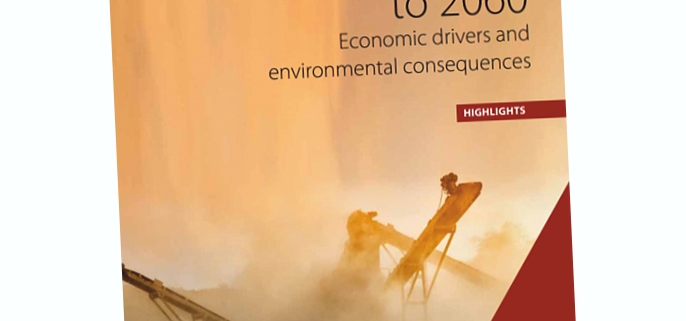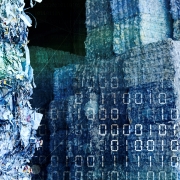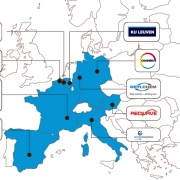OECD: Raw Materials Will Double by 2060
The expansion of global economy and the rise of living standards is set to force the world’s consumption of raw material to nearly double by 2060. The global materials use will increase to 167 Gigatons (Gt) in 2060 from 90 Gt today, according to a new report preview on the Global Material Resources Outlook to 2060 published by the Organisation for Economic Co-operation and Development (OECD).
The report predicts the world population soaring to ten billion people, an average global income per capita approaching the current OECD level and per capita growth rates emerging higher than in the OECD. Economic growth coupled with growing investment, infrastructure and construction will solidly increase the global materials use, especially of non-metallic minerals and metals increasing strongly. A changing demand from agriculture and industry to services will alter the economy and decrease the materials intensity (materials use per unit of output). Despite production growth, technological improvements are expected to slow down the material usage. In figures: The level of 2011 with 79 Gt will rise by 283 Gt caused by economic growth, but lowered through structural change by 112 Gt and technological change by 84 Gt, resulting in projected 167 Gt in 2060.
Greatest share: non-metallic minerals
The future increase of material use from cans be monitored at metals (8 Gt to 20 Gt), fossil fuels (14 Gt to 24 Gt), biomass (20 Gt to 37 Gt) and non-metallic minerals (37 Gt to 86 Gt), the latter including a share of sand, gravel and crushed rock. This material with a value of 24 Gt in 2011 will soar to 53 Gt in 2060. The use of primary and secondary metals is predicted to grow fastest, especially in BRIICS states (Brazil, Russia, India, Indonesia, China, South Africa) and developing countries. The non-metallic minerals use will increase rapidly – in the short run – because of investment demand, construction needs and lacking high-valued recycling. This increase concerns mostly developing countries; China is expected to be saturated with construction materials.
The recycling industry, currently a tenth the size of the mining sector in terms of GDP share, is likely to become more competitive than the mining of minerals and grow, but it will remain a much smaller industry than mining primary materials. Although the share of recycling in the global economy is ten times smaller than the share of mining, recycling will economically increase until 2060 by the factor 3.7 compared to mining with factor 2.6. Primary and secondary iron and steel will grow by factor 2.8. Primary non-ferrous metals are expected to put on by factor 3.0. Secondary non-ferrous metals will experience a mild decrease by 2060 effected by relatively high labor costs for the secondary production methods.
Material intensity rate will further decrease
From 1980 to 2017, the global material intensity rate decreased by -1,1 percent. In the future it will decrease by -1,3 percent: The annual growth of global GDP is estimated at 2,8 percent, while the usage of global materials use will rise by 1,5 percent per year. The resulting decrease of annually 1,3 percent is expected to be moderated after 2025 due to trends like more service and booming constructions slowing down. The change in material intensity from 2011 to 2060 – phrased in tons per US-Dollar – will mostly affect Eurasia (0.9 to 0.5), Asia (1.4 to 0.5), Middle East and Africa (0.8 to 0.5) as well as South America (0.8 to 0.4), less OECD America (0.5 to 0.3), OECD Europe (0.4 to 0.3) and OECD Pacific (0.6 to 0.5). Nevertheless, the level of material use is projected to rise between 2011 and 2060 from 27 to 38 Gt in China, from 9 to 23 Gt in India, and from 24 to 67 Gt in non-OECD countries, excluding China and India.
Objectives should be alike
Summarized, the figures show countries at different levels of material resources usage and of decoupling materials use from economic growth. But the objectives of resource efficiency and circular economy policies should be alike: increasing recycling, increasing the share of secondary resources, reducing waste streams, boosting economic growth, boosting employment and avoiding environmental impacts, not to forget opportunities for substituting secondary for primary materials. “This multitude of policy objectives requires a carefully balanced policy mix,” the report concludes. Angel Gurría, Secretary-General of the OECD, is quoted with the words: “This Outlook can help decision makers understand the direction in which we are heading and help to assess which policies can support a more circular economy.”
The preview of the “Global Material Resources Outlook to 2060. Economic drivers and environmental consequences” can be downloaded under www.oecd.org/environment/waste/highlights-global-material-resources-outlook-to-2060.pdf.
(GR 22019, Page 13)








